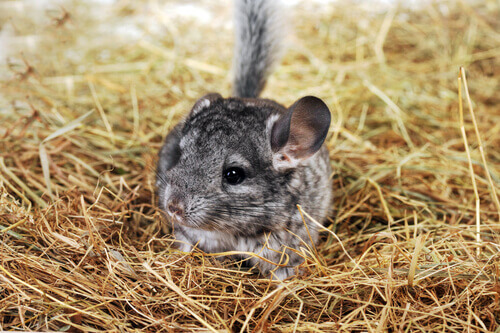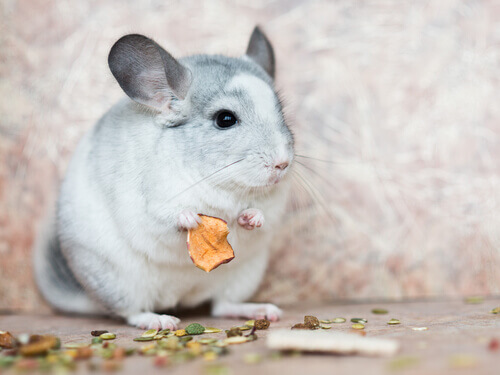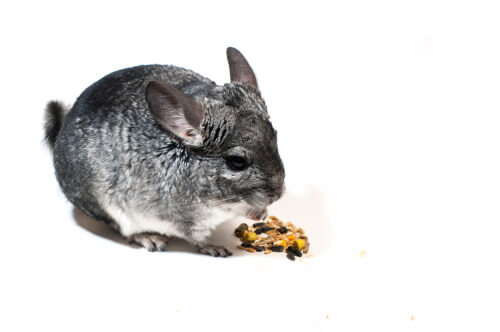Caring for Chinchillas: Physical Characteristics, Behavior, and Habitat

While chinchillas are famously known for their use of fur in the fur industry, these days they’re one of the top choices for pets. Caring for chinchillas is easy to do as they are docile, soft as velvet, and great companions with a fascinating history.
The domestic chinchilla comes from cross-breeding two wild species of chinchilla: the short-tailed chinchilla and the long-tailed chinchilla. As a result, we have the domesticated chinchilla, which is perfectly comfortable in captivity.
Physical characteristics
Domestic chinchillas are the biggest of the breeds, with the females weighing around a little over 1.5 pounds and the males just under, at 1.3 pounds. Due to their size, chinchillas have small paws with even smaller toes: four functional toes on the front feet and only three on the back, all with thin claws.
Chinchillas are known for their beautiful, thick coats that contain more the 50 hairs per follicle. Their coats come in handy when a predator captures them because they can shed fur when grabbed, helping the animal slip away.
Unfortunately, their soft, shiny coats (with more than 20,000 hairs per square inch!) was the reason for fur farmers targeting chinchillas in the first place. In the wild, chinchillas care for their coats by bathing in volcanic dust.
Wild chinchillas live for about 10 years, while the domestic breed can live up to 25 years. This is considered a long time for rodents to live, which is why many people select chinchillas as pets.

Behaviors
Chinchillas are vegetarians and eat dozens of plant species, especially grasses, though their diet changes according to the season. With respect to chinchillas in captivity, their diet typically consists of alfalfa, hay, and other fodder. This is important to keep that in mind when caring for chinchillas at home.
In the wild, these animals don’t seem to drink water, but this is because they receive adequate hydration through dew droplets. However, when caring for chinchillas in captivity, it’s necessary to give them access to water so they can remain hydrated.
Chinchillas communicate through different vocal sounds like barks, shrieks, and squeaks that vary in intensity and duration. They are nocturnal creatures, though they do have moments of activity at dusk and dawn.
These animals have a slow reproductive cycle. Chinchillas reach sexual maturity after five months of life and are in heat for five days every month. The typical gestation period is 111 days and, interestingly enough, baby chinchillas start eating solid foods almost immediately after birth.

Chinchillas burrow in the sand or under rocks, and live in large colonies of about 100 other animals, although some colonies can have up to 500 chinchillas. These rodents cover huge areas of land, which can reach nearly 250 acres per colony.
Wild chinchillas will burrow under rocks or in the ground. Chinchillas are native to cold climates, which is why they have such a thick coat. All chinchillas are herbivores and are very social creatures, typically living in colonies. Additionally, chinchilla litters have one to two babies.
Habitat and conservation
Chinchillas are rodents from arid climates, originating in the Andes mountains and the different countries surrounding this mountain range. Their wild habitats are sandy and rocky and contain herbs, cacti, and other spiny plants, which make up a large part of the chinchilla’s diet. When caring for chinchillas at home, try to replicate their native habitats as best you can.
Decades of intense chinchilla hunting has resulted in this species becoming practically extinct in the wild. Likewise, extensive exportation to European fur farms contributed to the scarcity of these animals in their natural habitat up until the early 20th century when several countries signed a treaty to protect wild chinchillas.
Despite the capturing of wild chinchillas now being illegal, the price of their fur increased, resulting in chinchilla poaching becoming a highly lucrative business. Although there are conservation projects to protect this species, some fear the population will continue to decline. Currently, chinchillas are illegally bred for their fur, in addition to being bred as pets.
All cited sources were thoroughly reviewed by our team to ensure their quality, reliability, currency, and validity. The bibliography of this article was considered reliable and of academic or scientific accuracy.
- Piñones C. & Zuleta C. (eds). (2014). La Chinchilla en Peligro Hoy: Guía Pedagógica para Trabajar la Problemática Actual de Conservación de la Chinchilla Chilena y su Entorno. Ministerio del Medio Ambiente & Red de Apoyo a la Conservación de la Chinchilla. Región de Coquimbo, Illapel, Chile.
- Álvarez, M. L. (2010). Manejo y crianza de la Chinchilla lanígera para la obtención de pieles en la Región de Magallanes (Doctoral dissertation, UNIVERSIDAD DE MAGALLANES).